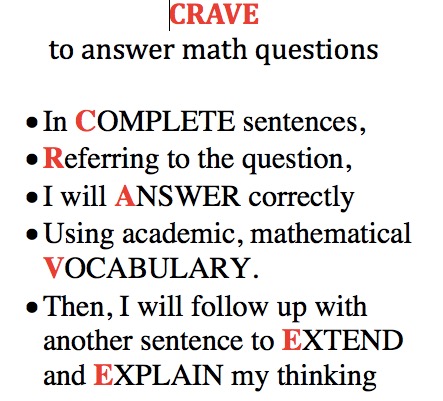Does it ever bug you when students are unable or unwilling to explain their thinking in math class? Does it bug you when some kids dominate conversation and others hide from it? Does it bug you when you give your students a really interesting problem or question to talk about and the conversations that ensue just aren’t what you were dreaming when you planned this lesson-o-excellence (or, even worse, *crickets*)? Does it bug you when you realize that you often rephrase student answers to be more precise than they initially were? Does it bug you when you realize that you are robbing students of the opportunity to practice attending to precision in their discussions?
It bugs us too.
Do you ever feel like kids are capable of much deeper, more nuanced discussion, but they just aren’t in the habit of comfortably speaking math?
We felt that way, too.
Three summers ago, during our yearly math institute, participating 6th – 12th grade math teachers agreed:
- We could do better at teaching kids how to talk math.
- We should assess what we want to grow, and be explicit about it with kids. If we believe that improving math talk is important, we ought to assess it formally.
Our Theory of Need:
1. Authentic integration of academic vocabulary into comfortable usage is difficult to achieve in math classrooms, particularly among disenfranchised student populations. Barriers to assimilating academic vocabulary as part of identity are complex, and include both student reticence to naturally use words that clash with their cultural and curated identities, as well as teacher philosophy of easing access to math content through the usage of synonyms or colloquial terms to ease this tension (which can, in turn, muddy the math).
2. We believe that students value growth that is graded, and that what we grade implicitly and explicitly announces what WE value. If we want to grow rich communication in our classroom, we ought to assess this objective. We theorize that students will place greater value on advancing the level of mathematical communication if we assess as part of a formal grade.
3. Students thrive when teacher expectations are clear. CRAVE is one attempt to advance a clarity of expectation around mathematical communication.
4. One barrier to rich communication in math classrooms is lack of practice, as well as lack of explicit feedback on how to improve.
So we decided to collectively implement a class routine of formally assessing oral responses to class questions. This was a new “part” of math class, as well as a new part of math assessment. We still have discussion, informal practice, solo and group problem solving and written assessments, but we also have CRAVE grades. CRAVE grades come from oral response to big idea questions or problems after students spend time in small group discussion. This strategy was tested and refined over the course of a year in our rural WV district, then further piloted and refined through Better Math Teaching Network partner teachers in Boston (Huge shout out to phenomenal teachers @CaseyAGreen and @franklyPINA). Over the course of the year, teachers began to notice big spill-over effects into student math conversation across settings, with students acclimating to a new “way” to talk math. Further, teachers saw huge growth in students ability to critique reasoning.
But nothing good is easy, amIright?
This strategy is NOT an overnight game-changer, and is certainly initially a challenge for teachers and students to undertake. But the payoff… Wow, is it worth it!
In case you’d like to give it a try, here’s our advice to get going. We think it’s best to dive in to this strategy and use it a few times per class period. Further, we “fake” the randomization of students as needed to achieve at least one grade per student for each testing cycle.
Strategy Outline:
- Classroom posters and desk copies of CRAVE acronym are visible. (You can contact me for PDF or word copies.
- Begin with a problem on the board (or a handout), and an appropriate amount of individual think time set on a timer/clock
- Ask groups to discuss solution pathways, and to prepare everyone in the group to be ready to speak through rehearsing responses (we say “prep your rep”). Remind students of the standards CRAVE that they must meet in order to score a 100% for their response.
- Draw a random student (S)he presents.
- Feedback is explicit
- teacher gives praise and feedback on which components of CRAVE were/(not) adequately met, one at a time… EX: “If I were to grade this response, I’d say that you did answer in complete sentences and were correct, with some reason stated. However, when you said “4, because…” you didn’t refer to the question so I wasn’t sure what exactly was 4, in your mind. Finally, I didn’t hear that follow up sentence that let me know how you arrived…”
- class revision – 1 minute revision together: How would you revise this answer to get a perfect 100%?
- Back to the original student to offer a chance for revision
- Again, share feedback explicitly. This time, for a grade. I recommend 50% for trying, then 10% additional for each of the 5 components.
Teachers have used multiple variations on this protocol, and there is not yet consensus of a best way. However, all teachers have seen marked improvement in willingness to talk math, and in the quality of the math talk. In one school, teachers have used this protocol for three years across all three middle school grade levels, and the difference in class conversations at 8th grade is truly remarkable.
Would you be willing to try CRAVE in your summer learning spaces, PD workshops or in the fall of next year? Be in touch and I’ll send along some PDF posters, as well as some supports for initially introducing CRAVE to your classes like this very basic example CRAVE problem with rubric.
CRAVE is an example of a strategy that emerged through collective honesty about what isn’t working as well as we’d like, a willingness to take a gander at some research and approaches that other folks are using, open minds to what the solution could be, and a scientific approach to tinkering towards making it better. All require us to stop pretending there’s a perfect answer that works perfectly well in all spaces. All make it more fun to teach, because we are in it together, and we are learning together. Shouldn’t that be what in-service PD is all about?



Do all students value growth that is graded?
LikeLike
Not at all my hypothesis (this blogging thing is a bit new, so I fear I may lose in writing translation what I can do a better job talking about). Rather, I think that, on average, students give greater attention to those things that are graded (OR that get explicit feedback). This might be something, in and of itself, that we want to change in classrooms… . THis strategry grew out of wondering why we as math teachers are beginning to talk about valuing reasoning over answer-getting, mistakes that are interesting, good math reasoning and critiquing, yet we still were only formally assessing answers. We came into this strategy with curiosity, and found that using it regularly did have big impact. Thanks for the question – do you think students value grades? Do you think grading something elevates its importance to the learner? What are grades for, anyway?
LikeLike
“Students thrive when teacher expectations are clear. CRAVE is one attempt to advance a clarity of expectation around mathematical communication.” I love this way of providing scaffolding for verbal responses. At the ELA cohort this year we talked about how the math program has been using this strategy to set expectations for how students should response to questions asked in the classroom, not only verbally but also in written expression. We also discussed how this strategy could be utilized across subjects to improve their overall academic writing.
LikeLike
Agreed, Erin! This sort of frame to build a (new) habit for student expression could well transfer across subject areas. It makes me think that there’s a next level of possibility within critiquing, and maybe that’s a natural extension. In fact, I bet that some of the tools of teaching debate could well be modified to elevate our classroom practice… Thanks for the read, and for suggestion for where we could move next.
LikeLike
Erin,
I *think* I’ll be doing an August session on CRAVE across subject areas. Would love to work with you on how to best modify for middle school ELA!
LikeLike
I learned CRAVE at the WV Quarterly Math Meeting back in Spring 2018. This strategy has been implemented in my cotaught Algebra II and cotaught Geometry classes. So far, it has worked well. My students of all abilities have for the most part bought into CRAVE. They have even taken it a step further by collaborating a script to follow in their groups should someone in the group be called to answer.
LikeLiked by 1 person
Joseph, what exciting news! I’m so glad this is making an impact on your classes and am so curious to learn how students came to collaborate on scripts… Do they write down a script for one another to read? Do you always allow them to do this? What benefit do you see it playing? Do you ever insist on no pencils … and if so, do kids still prepare together what they would like to say? Thanks so much for sharing, and please do tell me more! 🙂
LikeLike